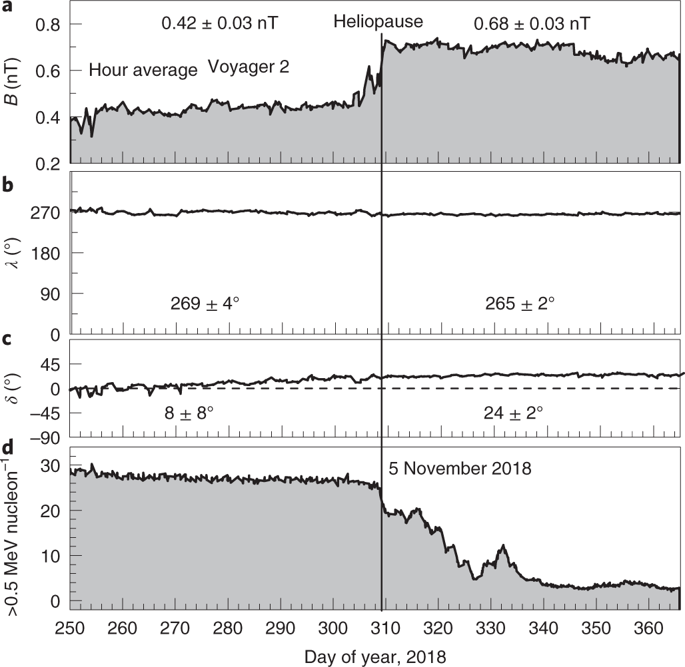Nature Astronomy ( IF 14.1 ) Pub Date : 2019-11-04 , DOI: 10.1038/s41550-019-0920-y L. F. Burlaga , N. F. Ness , D. B. Berdichevsky , J. Park , L. K. Jian , A. Szabo , E. C. Stone , J. D. Richardson

|
The heliopause is a boundary that separates the heliosheath (which contains magnetic fields and plasmas that originate in the Sun) from the interstellar medium (which contains magnetic fields and particles of stellar/interstellar origin). Observations of the heliopause were first made by the particles and fields instruments on the Voyager 1 spacecraft, moving radially in the northern hemisphere, which crossed the heliopause on 25 August 2012 at a distance of 121.6 au. We show using observations of the magnetic field and energetic particles that Voyager 2 crossed the heliopause in the southern hemisphere on 5 November 2018 at a distance of ≈119.0 au. Voyager 2 observed a much thinner and simpler heliopause than Voyager 1 as well as stronger interstellar magnetic fields, and it discovered a ‘magnetic barrier’ in the heliosheath adjacent to the heliopause that strongly influences the entry of cosmic rays into the heliosphere. The magnetic field direction observed by Voyager 2 changed smoothly from the time of arrival at the magnetic barrier, through it, and onwards into the interstellar medium, with a small (a few degrees) or no change across the heliopause. These observations, together with the Voyager 1 observations and existing models, show that the magnetic barrier, the heliopause and the neighbouring very local interstellar medium form a complex interconnected dynamical system.
中文翻译:

Voyager 2在更年期及其附近进行的磁场和粒子测量
绝经期是一个边界,将日鞘(其中包含来自太阳的磁场和等离子体)与星际介质(其中包含磁场和恒星/星际起源的粒子)分隔开来。首先通过旅行者1号飞船上的粒子和场仪器观测到了更年期,该仪器在北半球径向移动,并于2012年8月25日越过了最年期,距离121.6 au。我们使用磁场和高能粒子的观察结果显示,旅行者2号于2018年11月5日以≈119.0au的距离横越了南半球的更年期。与旅行者1号相比,旅行者2号观测到的更年期更薄,更简单,并且星际磁场更强,结果发现,在邻近日光浴的日光鞘中发现了一个“电磁屏障”,这强烈地影响了宇宙射线进入日光层的过程。从旅行者2到达磁障之时起,通过旅行者2所观察到的磁场方向平稳地变化,直至进入星际介质,整个绝经期的变化很小(几度)或没有变化。这些观测结果与Voyager 1观测值和现有模型一起表明,磁障,断层顶和邻近的非常局部的星际介质形成了一个复杂的相互联系的动力系统。然后进入星际介质,整个绝经期只有很小的变化(几度)或没有变化。这些观测结果与Voyager 1观测值和现有模型一起表明,磁障,断层顶和邻近的非常局部的星际介质形成了一个复杂的相互联系的动力系统。然后进入星际介质,整个绝经期只有很小的变化(几度)或没有变化。这些观测结果与Voyager 1观测值和现有模型一起表明,磁障,断层顶和邻近的非常局部的星际介质形成了一个复杂的相互联系的动力系统。



























 京公网安备 11010802027423号
京公网安备 11010802027423号